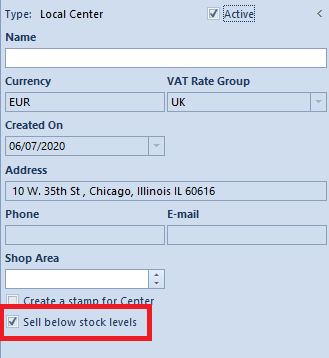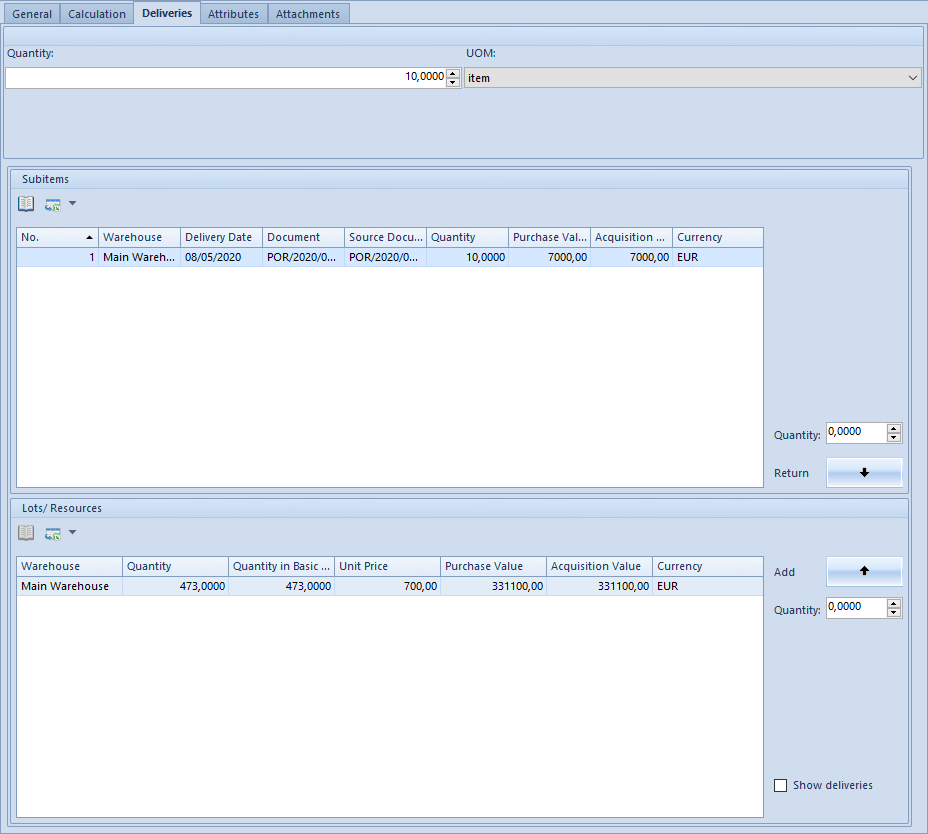The system allows for selling items, that is issuing confirmed trade documents for released items, whose resources have not yet been actually registered in a warehouse Thanks to that, the resources are already in the warehouse and can be subject to sales, even though a warehouse document for received items has not yet been entered to the system.
A warehouse document for released items (SOR) can be created when resources are present in a warehouse – a warehouse document for received items should be issued first. The item registered as shortage can be retrieved from the warehouse if there exists a sufficient amount of the resources whose date of receipt in the warehouse (e.g. the date of receipt in case of a POR document) is not later than the date of generating of the SOR document.
Configuration of sale below stock levels
The option of sale below stock levels can be enabled by checking parameter Sell below stock levels in definition of a given center company (Company Structure → Rights Structure → center/company edition), from the level of which such sales model is to be enabled.

The option of sale below stock levels is inactive by default. The parameter can be unchecked if:
- no shortages are registered in warehouses associated with a given center
- no POS workstation is associated with a company/center
The vendor issues a SI with its date of issue of 1 September 2018 and sales date of 4 September 2018, since will definitely be registered on that date.
On 4 September 2015, a warehouse operative registers the POR document whose items include the item AP and thus records the item in the stock records.
On the same day (4 September 2018), after confirming the POR document, the customer can come to collect the item AP that was purchased 3 days before Then, a SOR document is generated to the SI document issued before, whose subitems are associated with the subitems of the POR document.
Handling shortages in documents
When issuing a trade document, a user can indicate a warehouse from which the shortages are to be retrieved.
In case in a document header has been indicated:
- a warehouse from the list of warehouses available for SI or R document, all added items are assigned to that warehouse
- option <All>, items are associated with the <<default warehouse>> defined in company structure for a given document for released items
Adding items to a document has been described in article: <<LINK>>.
In the there are shortages in a document:
- the margin on an item is calculated on the basis of the applicable sales price list for a given item (if there are no resources) or the purchase price increased by the margin for a given item (if there exists at least one unit in the stocks and its price from the sales price list is does not meet the minimum margin requirements). While generating a warehouse document, the system does not verify whether the minimum margin is achieved – the prices on the generated SOR document will be set according to prices specified on the trade document.
- subitems of item in columns: Delivery Date, Document, Source Document are empty. The columns with Purchase Value and Acquisition Value take on a value equal to 0.00, whereas the columns with features may remain empty (then, while generating a SOR document, the system retrieves resources with any features values) or may take on a specific value – however, it must be remembered that all subitems of a given item must have the same values of features.

Registered warehouse shortages of a specified resource are displayed:
- in the list of stock levels, on an item form, in the tab Resources → <<Resources and lots>>, in the column Shortages
- ona warehouse form, in the tab <<Stock Level>>
- on the <<Archival Stock Levels>> form, in the column Shortages
Elimination of shortages
Shortages can be eliminated in two ways:
- Manually – when generating a warehouse document for released items (SOR) from a trade document (SI, R) which has subitems sold below stock levels, it is verified whether on the current day appropriate resources exist in the warehouse. If so, the released item subitems are associated with the corresponding received item subitems
- With BPM process Restock Shortages Automatically – the process automates generation of warehouse documents to sales invoices and receipts in which shortages have been registered. It can be run in several ways:
- confirmation of POR, IR+, WM+ – the process is started automatically upon confirming the listed documents. In this case the process adds missing warehouse documents on the on-going basis. For items included in a delivery document, the process verifies shortages registered in the system. Next, it generates warehouse documents (SOR) to sales invoices or receipts pointing to lack of resources for received items and thus it eliminates shortages in a warehouse.
- from the level of POR, IR+, WM+ lists – it is also possible to start the process manually for specific deliveries by selecting given documents on the list and running the process from context menu In this case the process operates the same way as in case of confirming a delivery document.
- from the level of Inbox – if shortages are to be restocked recurrently and not each time a delivery is confirmed. In this case the process verifies all sales invoices and receipts in which shortages are registered and attempts to generate missing warehouse documents (SOR) with the use of resources available in warehouses. Information about all documents pointing to shortages and about generated documents is sent to operator indicated in the startup parameter or to the process initiator.
